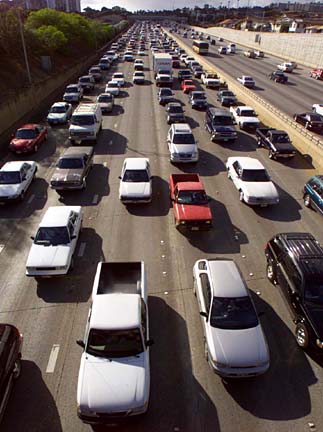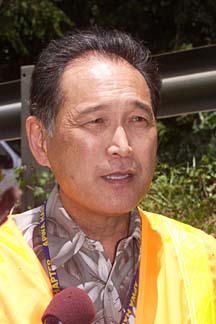
STAR-BULLETIN / 2001
Traffic inches along as usual on the H1 eastbound.
No time to waste
The transit plan has
government support -- now
the public must get on board
When it comes to finding solutions for traffic congestion on Oahu, you could say we're standing at a crossroads.
One path already has been well traveled. It involved lots of transportation studies and community meetings, but ultimately our government leaders did not reach a consensus on a far-reaching transit plan for Oahu. That path of inaction led to a dead end, and now we're paying the price -- you can see traffic from Leeward and Central Oahu into town getting worse each year.
STAR-BULLETIN
"We need to put a long-term transportation plan into action, and we need to do it now." --Rodney Haraga, director, state Department of Transportation
Then there's the path we have chosen. It is a challenging path, to be sure, and the price is certainly not cheap -- about $2.8 billion total. And it will take time to get there. But if we don't take the path of action and effectively address our traffic problems, we'll soon be facing gridlock during morning and evening commutes, not to mention midday business travel. That's a far more expensive price to pay.
A transportation task force organized by Gov. Linda Lingle has come up with a viable plan for avoiding gridlock, and substantial amounts of federal funding are available to ease the financial burden on Hawaii. This plan deserves broad community support.
Taking a lesson from where her predecessors drove a different course of action, Lingle decided the best approach was first to bring together transportation officials and city, state and federal lawmakers to create a workable transit plan. After five meetings, the task force convened and -- led by the governor -- reached a consensus, and the proposal was unveiled to the public.
That was a 180-degree switch from the previous, unsuccessful approach, which involved seeking community support initially and then trying in vain to achieve a political consensus.
The current transportation plan calls for a Nimitz "Flyover," an elevated two-lane road from the Keehi Interchange to Pacific Street. The federal government would pay for 80 percent of this $250 million project.
But there's a caveat: If the proposal is not submitted to the federal government by 2004, we'll have to wait six more years until the next funding cycle arrives. The reality is, traffic will only get worse if the project is delayed once again.
The transportation plan also calls for a 22-mile elevated light-rail system extending from the Kapolei area to Iwilei. The Nimitz "Flyover" eventually would be converted to be part of this fixed-rail system for electric-powered trains. This approach would not take away any existing state highway or freeway lanes, and federal funds would pay for at least half the costs.
Much media attention predictably has focused on the light-rail system because of the project's magnitude and cost. And some people are asking why we're taking another look at an idea that has been debated and rejected before. There are many compelling reasons:
>> Oahu's population is listed at 880,000 in the latest U.S. census. That number is expected to increase to more than 1 million by the year 2020. With new homes being constructed in Central and Leeward Oahu, it is almost certain that the population will continue to shift in that direction.Let's be clear: The city of Honolulu would be responsible for building and operating a light-rail system. However, as a true leader, the governor understood the need to achieve consensus among all levels of government to make this work. That was her charge from our congressional delegation, and she made it happen. The delegation will be responsible for helping to obtain federal funding.>> Our highways are already at capacity or over capacity. In 1998, Oahu already had almost 600,000 registered vehicles. Today there are 631,000 registered vehicles on our island. Without another commuting option, the number of people driving on our roads is guaranteed to increase.
>> Because we live on a small, developed island, we're basically hindered from building new highways and freeways, with the exception of expensive projects to add a lane here or there for a short distance. We are planning to widen the H-1 freeway near Waimalu, for instance, and that project, which is already funded, will cost us $52 million.
The governor also was upfront about the fact that this project will require revenues beyond what we have today. Rather than hiding or avoiding reality, Hawaii's chief executive spoke in plain, common-sense language about how a tax increase will be necessary to pay for such a system.
There already is opposition from residents in certain areas who believe they would not benefit directly from a light-rail system along the Leeward coast. But if government does not provide another commuting option from Central/ Leeward Oahu into downtown, that will mean more cars heading into an already congested Honolulu. And that would affect everyone.
State taxpayers previously have paid for part of the construction costs of the H-3 freeway. Some people argued that this project would benefit only Windward residents, when it actually improved traffic flow along other roadways. When Kalanianaole Highway was widened, it helped East Honolulu residents in particular. But we all paid for the construction.
Some people are suggesting that we double-deck the freeways coming into town, as an alternative to light rail. Aside from the daunting logistics of adding second freeway levels while minimizing traffic disruptions, this would only encourage more people to drive, which is the problem we're trying to solve in the first place.
Please keep in mind that we're still very early in the planning process for light rail. During the four years it will take to complete an environmental impact study, we'll examine various factors, including con- struction and operational costs, ridership projections, noise and visual impacts and right-of-way issues.
Whether or not you agree with the fixed-rail proposal, I hope the debate brings about a healthy discussion of our worsening traffic problems. Doing nothing about congestion is not an option. Passing this problem on to the next generation is not an option. By the time our children would be forced to deal with these transportation issues, the challenges may be insurmountable.
Eleven years have passed since the last attempt to build an Oahu rail transit system, and one thing is certain: The traffic situation has worsened. Can you imagine what traffic will be like 10 or 20 years from now if we continue to do nothing?
We need to put a long-term transportation plan into action, and we need to do it now.
Rodney Haraga is the director of the state Department of Transportation.

